A few weekends ago, I was returning into Manhattan from upstate New York. Coming down the FRD along the East River, we past Keith Haring’s “Crack is Wack” mural on 128th and 2nd. I remember the first time I saw it in the 80s on a family day trip into the city. The work is strikes me as quite extraordinary, even 20 years after its creation in 1986. By that time, Haring was established in the art world, having already shown at the Venice Biennale and the Whitney Biennial and had solo shows at the Tony Shafrazi Gallery and the Leo Castelli Gallery. Even though Haring was part of that contemporary/ high brow art world, he still maintained a connection to his roots of skirting the lines between public street art and illegal graffiti. “Crack is Wack” mixed of graffiti street culture, political and social messages, and high art. Although, the mural was quickly placed under the protection and jurisdiction of the City Department of Parks.
Haring took cues from graffiti, among other sources of influence, and created his own style and form. Revisiting “Crack is Wack” got me thinking about graffiti and how it has evolved of the past few decades. The funny thing about living in New York is that, after a while, you start seeing through the visual chaos of our surroundings. When you take a moment to stop and look, it is amazing what you can actually see. The things that you walk by everyday, especially stand out.
Graffiti, which had faded into the background visual noise of New York, was back on my radar screen. It was, of course, everywhere, but it had also changed since I really paid attention to it. Ben posted about a show on graffiti at the Brooklyn Museum, and that was just one aspect of how graffiti has expanded beyond the traditional notions of the form. At the institute, we spend a lot of time thinking about the evolution of media, and it seems that graffiti is no different.
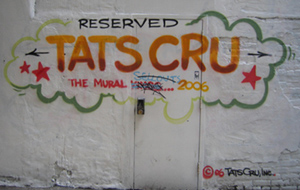 On a side street near Little Italy, there used to be an advertisement for the Sony PSP done by the graffiti artists Tat’s Cru. Now, the brick space has a place holder of an advertisement for these graffiti artists for hire. An interesting comment was left by a rival tagger, saying “sell out.” And then someone else left their tag over the unsolicited commentary. I love the on-going asynchronous dialogue occurring on this brick wall of this corner deli. It is not surprising that others would be upset at Tat’s Cru getting paid by advertisers for marketing. The website shows a piece that they did for BP. Working for the oil industry certainly will raise doubts to the authenticity and street credibility by purists of the form.
On a side street near Little Italy, there used to be an advertisement for the Sony PSP done by the graffiti artists Tat’s Cru. Now, the brick space has a place holder of an advertisement for these graffiti artists for hire. An interesting comment was left by a rival tagger, saying “sell out.” And then someone else left their tag over the unsolicited commentary. I love the on-going asynchronous dialogue occurring on this brick wall of this corner deli. It is not surprising that others would be upset at Tat’s Cru getting paid by advertisers for marketing. The website shows a piece that they did for BP. Working for the oil industry certainly will raise doubts to the authenticity and street credibility by purists of the form.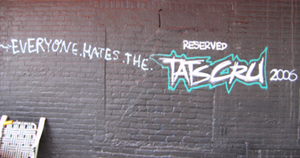
Perhaps, the work of the Tats Cru has not branched off to the new genre of graffiti but circled back to another form. Take this painted billboard for the debut solo record by Radiohead frontman Thom Yorke. The billboard appeared in Williamsburg in the weeks leading up to its release. Within moments, my initial thought that it was some hard core fan’s ode to British rock was replaced with the realization that this was paid for by a record label.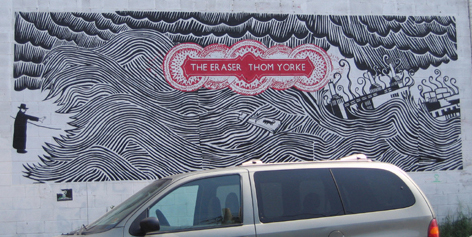
Referencing graffiti in advertising is nothing new. Turning actual graffiti into the advertising was the obvious next step. If graffiti is paid for and created for marketing purposes, at what point does it stop being graffiti? Has it turned into something else? Is it just a style of art using spray paint to create forms referencing hip-hop?
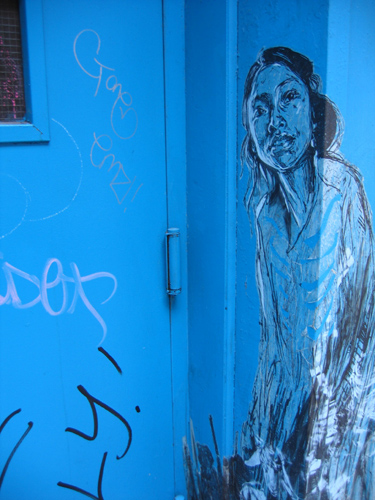 Sometime after seeing Haring work, I passed this stoop a few blocks north of Chinatown. There was another similar work by the same artist I saw in the Lower East Side, however, I couldn’t find it again.
Sometime after seeing Haring work, I passed this stoop a few blocks north of Chinatown. There was another similar work by the same artist I saw in the Lower East Side, however, I couldn’t find it again.
But the work kept on reappearing. And then, I noticed another one a few blocks from the institute’s office in Brooklyn. I probably walked past it hundreds of times before stopping to notice it. You can see where someone tried to tear it off, because in fact, the figures are not drawn on the wall, but on paper. The image is then transferred to the wall. Is this cheating? Suddenly, form and material are being challenged.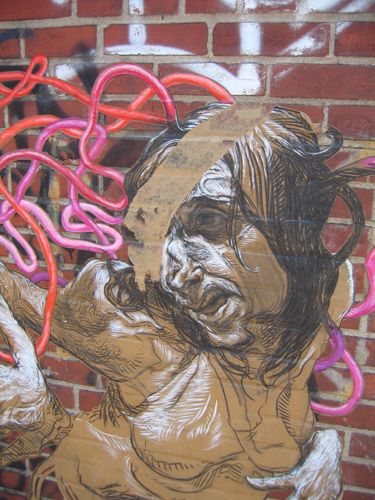
I did stumble upon Ping Magazine, when a friend sent me another article from the site. I finally learned that these pieces were created by an artist who goes by Swoon. She gave an interview for the New York Times, and describes herself as street artist, but considers her work graffiti. More importantly, she does not talk about the legal nature or the materiality of her work, but focuses on its location in public spaces and its direction interaction with people.
Keith Haring ended up being a great starting point, because of his work is a hybrid many forms and influences, including graffiti but also things beyond it. His mural reminded me that graffiti has embodied a range of politics, material and cultures for decades. Forms of expression emerge, branch off and circle back. Subsequent generations focus on different areas, be it monetary or expressive. Today, art and advertising are often re-appropriations of each other, as forms blend into one another. Empty spaces are filled with media by both artists and advertisers. The arts organization the Wooster Collective shows how broadly the concept of street art can extended. Trying to restrict these forms to bounded definitions is marginally useful, and often futile.
In this investigation, I was surprised at what I found, and amused at how often I circled back to the question of what is graffiti? The question or process of re-seeing something itself is not that surprising, particularly in the context of our work at the institute. Although, we focus more time on textual media, many of the questions remain the same. As we witness the evolving forms of text and the book, we can learn from other forms that turn into something slightly familiar but also remarkably new.
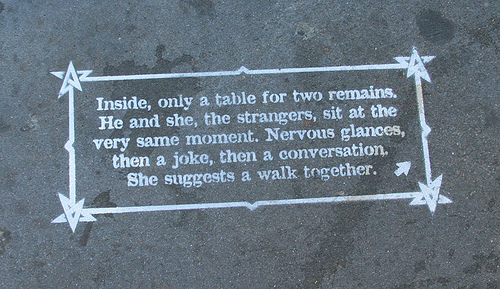

 On a side street near Little Italy, there used to be an advertisement for the Sony PSP done by the graffiti artists
On a side street near Little Italy, there used to be an advertisement for the Sony PSP done by the graffiti artists 

 Sometime after seeing Haring work, I passed this stoop a few blocks north of Chinatown. There was another similar work by the same artist I saw in the Lower East Side, however, I couldn’t find it again.
Sometime after seeing Haring work, I passed this stoop a few blocks north of Chinatown. There was another similar work by the same artist I saw in the Lower East Side, however, I couldn’t find it again.